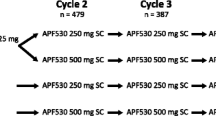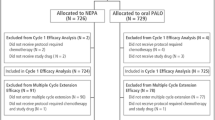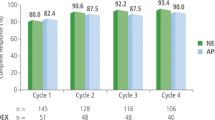Abstract
Purpose
Despite a lower risk of nausea and vomiting in patients receiving radiotherapy to the upper abdomen (UA-RINV) with prophylactic 5-HT3 antagonist therapy, patients can still experience UA-RINV. The aim of this multicenter phase II study was to assess effectiveness, safety, and tolerability of protracted dual NK1-receptor and 5-HT3 antagonist prophylaxis against UA-RINV.
Methods
Patients receiving fractionated radiotherapy with radiosensitizing chemotherapy received oral ondansetron 8 mg po q12 h and aprepitant 125/80/80 mg on a Monday, Wednesday, Friday schedules throughout radiotherapy. The primary outcome was complete response (CR) defined as no vomiting or rescue therapy during the entire observation period of radiotherapy (OP). Nausea, vomiting, and use of rescue medication were recorded in a modified version of the MASCC antiemesis tool completed twice weekly.
Results
Fifty-five patients were enrolled at 5 sites, 52 of whom were evaluable. 57.7% of patients (30/52, 95% CI 43.2–71.3%) achieved CR on study, with 73.1% (38/52, 95% CI 59.0–84.4%) who did not vomit, and 71.2% (37/52, 95% CI 56.9–82.9%) who did not use rescue medication during the OP. Overall, participants vomited or experienced significant nausea (SN) for an average of 6.8% (95% CI 11.4–21.0) and 8.4% (95% CI 4.2–12.7%) of time on study, respectively. Nausea was common with 32 (61.5%) reporting SN at any time during the OP.
Conclusions
UA-RINV remains an important morbidity despite the advent of modern radiotherapy. Aprepitant and ondansetron as dosed in this trial was not superior to standard ondansetron monotherapy.


Similar content being viewed by others
Abbreviations
- RINV:
-
Radiation induced nausea and vomiting
- OP:
-
Observation period
- RTP:
-
Radiation therapy period
- PK:
-
Pharmacokinetic
- UA:
-
Upper abdominal
- CR:
-
Complete response
- SN:
-
Significant nausea
- AN:
-
Any nausea
- 5-HT3:
-
5-Hydroxytryptamine
References
Kris MG, Hesketh PJ, Somerfield MR, Feyer P, Clark-Snow R, Koeller JM, Morrow GR, Chinnery LW, Chesney MJ, Gralla RJ, Grunberg SM (2006) American Society of Clinical Oncology guideline for antiemetics in oncology: update 2006. J Clin Oncol 24(18):2932–2947
Priestman TJ, Priestman SG (1984) An initial evaluation of nabilone in the control of radiotherapy-induced nausea and vomiting. Clin Radiol 35(4):265–266
Feyer P, Zimmermann JS, Titlbach OJ, Buchali A, Hinkelbein M, Budach V (1998) Radiotherapy-induced emesis. An overview. Strahlenther Onkol 174(Suppl 3):56–61
Feyer PC, Stewart AL, Titlbach OJ (1998) Aetiology and prevention of emesis induced by radiotherapy. Support Care Cancer 6(3):253–260
Priestman TJ, Roberts JT, Lucraft H, Collis CH, Adams M, Upadhyaya BK, Priestman S (1990) Results of a randomized, double-blind comparative study of ondansetron and metoclopramide in the prevention of nausea and vomiting following high-dose upper abdominal irradiation. Clin Oncol (R Coll Radiol) 2(2):71–75
Spitzer TR, Bryson JC, Cirenza E, Foelber R, Wallerstadt M, Stout C, Kunka RL, Plagge PB, Dubois A (1994) Randomized double-blind, placebo-controlled evaluation of oral ondansetron in the prevention of nausea and vomiting associated with fractionated total-body irradiation. J Clin Oncol 12(11):2432–2438
Tramer MR, Reynolds DJ, Stoner NS, Moore RA, McQuay HJ (1998) Efficacy of 5-HT3 receptor antagonists in radiotherapy-induced nausea and vomiting: a quantitative systematic review. Eur J Cancer 34(12):1836–1844
LeBourgeois JP, McKenna CJ, Coster B, Feyer P, Franzen L, Goedhals L, Marzecki Z, Souhami L, Stewart A, Tonnessen F, Haigh C, Mitchell T, Wilkinson JR, Graham E (1999) Efficacy of an ondansetron orally disintegrating tablet: a novel oral formulation of this 5-HT(3) receptor antagonist in the treatment of fractionated radiotherapy-induced nausea and emesis. Emesis study Group for the Ondansetron Orally Disintegrating Tablet in radiotherapy treatment. Clin Oncol (R Coll Radiol) 11 (5):340–347
Priestman TJ, Roberts JT, Upadhyaya BK (1993) A prospective randomized double-blind trial comparing ondansetron versus prochlorperazine for the prevention of nausea and vomiting in patients undergoing fractionated radiotherapy. Clin Oncol (R Coll Radiol) 5(6):358–363
Franzen L, Nyman J, Hagberg H, Jakobsson M, Sorbe B, Nyth AL, Lomberg H, Henriksson R (1996) A randomised placebo controlled study with ondansetron in patients undergoing fractionated radiotherapy. Ann Oncol 7(6):587–592
Hesketh PJ, Bohlke K, Lyman GH, Basch E, Chesney M, Clark-Snow RA, Danso MA, Jordan K, Somerfield MR, Kris MG (2015) Antiemetics: American Society of Clinical Oncology focused guideline update. J Clin Oncol. doi:10.1200/JCO.2015.64.3635
National Cancer Institute of Canada Clinical Trials G, Wong RK, Paul N, Ding K, Whitehead M, Brundage M, Fyles A, Wilke D, Nabid A, Fortin A, Wilson D, McKenzie M, Ackerman I, Souhami L, Chabot P, Pater J (2006) 5-hydroxytryptamine-3 receptor antagonist with or without short-course dexamethasone in the prophylaxis of radiation induced emesis: a placebo-controlled randomized trial of the National Cancer Institute of Canada clinical trials group (SC19). J Clin Oncol 24(21):3458–3464. doi:10.1200/JCO.2005.04.4685
Basch E, Prestrud AA, Hesketh PJ, Kris MG, Feyer PC, Somerfield MR, Chesney M, Clark-Snow RA, Flaherty AM, Freundlich B, Morrow G, Rao KV, Schwartz RN, Lyman GH, American Society of Clinical O (2011) Antiemetics: American Society of Clinical Oncology clinical practice guideline update. J Clin Oncol 29(31):4189–4198. doi:10.1200/JCO.2010.34.4614
Blackstock A, Ayala D, Squire S, Levine E, Howerton R, McQuellon R, Aklilu M (2009) A reduction in chemoradiation-induced nausea and vomiting (CRINV) with prophylactic aprepitant/5HT-3/dexamethasone therapy during upper abdominal chemoradiation. Int J Radiat Oncol Biol Phys 75(3, Supplement):S520
Tan L, Liu J, Liu X, Chen J, Yan Z, Yang H, Zhang D (2009) Clinical research of olanzapine for prevention of chemotherapy-induced nausea and vomiting. Journal of experimental & clinical cancer research : CR 28:131. doi:10.1186/1756-9966-28-131
Navari RM, Gray SE, Kerr AC (2011) Olanzapine versus aprepitant for the prevention of chemotherapy-induced nausea and vomiting: a randomized phase III trial. The journal of supportive oncology 9(5):188–195. doi:10.1016/j.suponc.2011.05.002
Navari RM, Koeller JM (2003) Electrocardiographic and cardiovascular effects of the 5-hydroxytryptamine3 receptor antagonists. Ann Pharmacother 37(9):1276–1286. doi:10.1345/aph.1C510
Kip KE, Cohen F, Cole SR, Wilhelmus KR, Patrick DL, Blair RC, Beck RW, Herpetic Eye Disease Study G (2001) Recall bias in a prospective cohort study of acute time-varying exposures: example from the herpetic eye disease study. J Clin Epidemiol 54(5):482–487
Rapoport BL, Chasen MR, Gridelli C, Urban L, Modiano MR, Schnadig ID, Poma A, Arora S, Kansra V, Schwartzberg LS, Navari RM (2015) Safety and efficacy of rolapitant for prevention of chemotherapy-induced nausea and vomiting after administration of cisplatin-based highly emetogenic chemotherapy in patients with cancer: two randomised, active-controlled, double-blind, phase 3 trials. The Lancet Oncology 16(9):1079–1089. doi:10.1016/S1470-2045(15)00035-2
Acknowledgements
We want to remember Dr. Steven Grunberg, who was a key original investigator in the conception and drafting of the protocol for this study before his untimely passing in 2014. His leadership and vision in the field of supportive care in cancer has been an inspiration to all investigators who participated in this study and the broader oncology community.
Support
This project was supported by an industry grant for Merck. The content is solely the responsibility of the authors. ClinicalTrials.gov identifier: NCT00970905.
The following institutions participated in the study:
1. University of Vermont Cancer Center, Burlington, VT
2. Mayo Clinic, Scottsdale, AZ
3. Wake Forest University Baptist Medical Center, NC
4. Dartmouth Hitchcock Medical Center
5. University of Massachusetts Memorial Medical Center
Author information
Authors and Affiliations
Corresponding author
Rights and permissions
About this article
Cite this article
Ades, S., Halyard, M., Wilson, K. et al. Effectiveness of aprepitant in addition to ondansetron in the prevention of nausea and vomiting caused by fractionated radiotherapy to the upper abdomen (AVERT). Support Care Cancer 25, 1503–1510 (2017). https://doi.org/10.1007/s00520-016-3540-4
Received:
Accepted:
Published:
Issue Date:
DOI: https://doi.org/10.1007/s00520-016-3540-4




